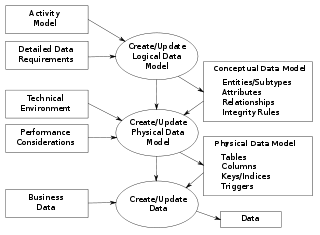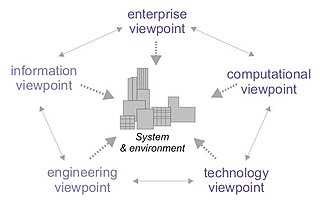Related Research Articles
A modeling language is any artificial language that can be used to express data, information or knowledge or systems in a structure that is defined by a consistent set of rules. The rules are used for interpretation of the meaning of components in the structure of a programming language.

BEA Systems, Inc. was a company that specialized in enterprise infrastructure software products, which was wholly acquired by Oracle Corporation on April 29, 2008.
In software engineering, service-oriented architecture (SOA) is an architectural style that focuses on discrete services instead of a monolithic design. SOA is a good choice for system integration. By consequence, it is also applied in the field of software design where services are provided to the other components by application components, through a communication protocol over a network. A service is a discrete unit of functionality that can be accessed remotely and acted upon and updated independently, such as retrieving a credit card statement online. SOA is also intended to be independent of vendors, products and technologies.

Data modeling in software engineering is the process of creating a data model for an information system by applying certain formal techniques. It may be applied as part of broader Model-driven engineering (MDE) concept.
Enterprise architecture (EA) is a business function concerned with the structures and behaviours of a business, especially business roles and processes that create and use business data. The international definition according to the Federation of Enterprise Architecture Professional Organizations is "a well-defined practice for conducting enterprise analysis, design, planning, and implementation, using a comprehensive approach at all times, for the successful development and execution of strategy. Enterprise architecture applies architecture principles and practices to guide organizations through the business, information, process, and technology changes necessary to execute their strategies. These practices utilize the various aspects of an enterprise to identify, motivate, and achieve these changes."

The Open Group Architecture Framework (TOGAF) is the most used framework for enterprise architecture as of 2020 that provides an approach for designing, planning, implementing, and governing an enterprise information technology architecture. TOGAF is a high-level approach to design. It is typically modeled at four levels: Business, Application, Data, and Technology. It relies heavily on modularization, standardization, and already existing, proven technologies and products.

An enterprise architecture framework defines how to create and use an enterprise architecture. An architecture framework provides principles and practices for creating and using the architecture description of a system. It structures architects' thinking by dividing the architecture description into domains, layers, or views, and offers models – typically matrices and diagrams – for documenting each view. This allows for making systemic design decisions on all the components of the system and making long-term decisions around new design requirements, sustainability, and support.
Service-orientation is a design paradigm for computer software in the form of services. The principles of service-oriented design stress the separation of concerns in the software. Applying service-orientation results in units of software partitioned into discrete, autonomous, and network-accessible units, each designed to solve an individual concern. These units qualify as services.

Reference Model of Open Distributed Processing (RM-ODP) is a reference model in computer science, which provides a co-ordinating framework for the standardization of open distributed processing (ODP). It supports distribution, interworking, platform and technology independence, and portability, together with an enterprise architecture framework for the specification of ODP systems.

Enterprise modelling is the abstract representation, description and definition of the structure, processes, information and resources of an identifiable business, government body, or other large organization.
Network Agility is an architectural discipline for computer networking. It can be defined as:
Service-oriented modeling is the discipline of modeling business and software systems, for the purpose of designing and specifying service-oriented business systems within a variety of architectural styles and paradigms, such as application architecture, service-oriented architecture, microservices, and cloud computing.

Dennis E. Wisnosky is an American consultant, writer and former chief architect and chief technical officer of the US DoD Business Mission Area (BMA) within the Office of Business Transformation. He is known as one of the creators and initiators of the Integrated Definition (IDEFs) language, a standard for modeling and analysis in management and business improvement efforts.

A semantic data model (SDM) is a high-level semantics-based database description and structuring formalism for databases. This database model is designed to capture more of the meaning of an application environment than is possible with contemporary database models. An SDM specification describes a database in terms of the kinds of entities that exist in the application environment, the classifications and groupings of those entities, and the structural interconnections among them. SDM provides a collection of high-level modeling primitives to capture the semantics of an application environment. By accommodating derived information in a database structural specification, SDM allows the same information to be viewed in several ways; this makes it possible to directly accommodate the variety of needs and processing requirements typically present in database applications. The design of the present SDM is based on our experience in using a preliminary version of it. SDM is designed to enhance the effectiveness and usability of database systems. An SDM database description can serve as a formal specification and documentation tool for a database; it can provide a basis for supporting a variety of powerful user interface facilities, it can serve as a conceptual database model in the database design process; and, it can be used as the database model for a new kind of database management system.

A view model or viewpoints framework in systems engineering, software engineering, and enterprise engineering is a framework which defines a coherent set of views to be used in the construction of a system architecture, software architecture, or enterprise architecture. A view is a representation of the whole system from the perspective of a related set of concerns.

Business reference model (BRM) is a reference model, concentrating on the functional and organizational aspects of the core business of an enterprise, service organization or government agency.
Steven Howard Spewak was an American management consultant, author, and lecturer on enterprise architectures, known for the development of Enterprise Architecture Planning (EAP).

Praxeme is a methodology for enterprise architecture which provides a structured approach to the design and implementation of an enterprise information architecture.
Oliver Sims was a British computer scientist, former IBM employee, and enterprise architecture consultant, known for his work on business objects Object-oriented programming, and service-oriented architecture (SOA).
The history of business architecture has its origins in the 1980s. In the next decades business architecture has developed into a discipline of "cross-organizational design of the business as a whole" closely related to enterprise architecture. The concept of business architecture has been proposed as a blueprint of the enterprise, as a business strategy, and also as the representation of a business design.
References
- ↑ Richard Veryard Accessed 17 December 2008.
- 1 2 3 Richard Veryard Principal Consultant at CBDI. Accessed 17 December 2008.
- ↑ Sandro Bologna, Giacomo Bucci (ed.) (1996) Achieving Quality in Software: Proceedings of the Third International Conference on Achieving Quality in Software. Chapman & Hall. p.425.
- ↑ Graeme Simsion (2001). Data Modeling. p.26.
- ↑ Richard Veryard (1984). Pragmatic data analysis. Oxford : Blackwell Scientific Publications. p.7
- ↑ Mehdi Khosrowpour (1999) (ed.). Managing Information Technology Resources in Organizations in the Next Millennium. p. 30.
- ↑ Grady Booch (1991). Object Oriented Design with Applications: with applications. Benjamin/Cummings Pub. Co., 1991. p.151.
- 1 2 Graeme Simsion (2007) Data Modeling: Theory and Practice. p. 78.
- ↑ Richard Veryard (1991). The Economics of Information Systems and Software. Butterworth-Heinemann.
- 1 2 Richard Veryard (1993). Information Coordination: The Management of Information Models, Systems, and Organizations. Prentice Hall.
- ↑ Ayers, Michael (January 1996). "Critical review of Information Coordination". ACM SIGSOFT Software Engineering Notes. 21 (1). Retrieved 11 June 2010.
- ↑ Richard Veryard and Ian G. MacDonald (1994). "EMM/ODP: A methodology for federated and distributed systems". In: Methods and Associated Tools for the Information Systems Life Cycle, Proceedings of the IFIP WG8.1 Working Conference on Methods and Associated Tools for the Information Systems Life Cycle, Maastricht, The Netherlands, 26–28 September 1994. Alex A. Verrijn-Stuart and T. William Olle (ed.) Elsevier IFIP Transactions. pp.241-273.
- ↑ Business relationship modelling Veryard Projects. Accessed 16 December 2008.
- 1 2 3 Richard Veryard (2001). Component-based Business: Plug and Play. Springer.
- ↑ Michael Bell, SOA Modeling Patterns for Service-Oriented Discovery and Analysis (Wiley 2010); Tony Bidgood, ArchiMate: A Standard for Enterprise System Modelling (CBDI Journal, August 2008); Marc Lankhorst et al, Enterprise Architecture at Work (Springer, 2005)
- 1 2 Veryard (2013, p. i)
- ↑ Richard Veryard List of publications from the DBLP Bibliography Server.